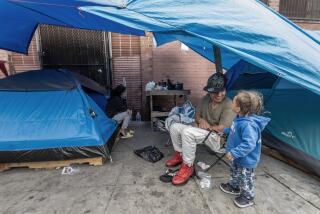Shelter Gives Homeless a Roof--and a Recharge : Salvation Army Facility in Bell Stresses Job Training
Every evening, William P. Morris arrives at the Bell Homeless Shelter--and dives into his thick auto mechanics textbook and class notes.
He expects to graduate from auto mechanics school soon and hopes to find a job that will pay for permanent housing.
“I’m studying as hard as I can,” Morris, 27, said recently as he waited for a Salvation Army van to take him from the shelter to classes in Compton. “I’m an artist, but an artist has to give up a lot. You don’t make much money doing that.” He came to Southern California from Texas three months ago looking for work.
The shelter on Rickenbacker Road seeks out men and women in Morris’ situation--people who can’t afford a place to live and can’t find a permanent job, but have a desire to change all that.
Unlike many other shelters in the county, the operators of the Bell shelter focus on helping homeless people gain job skills, find work and save money, said Salvation Army Capt. David Hudson, administrator of the 18,000-square-foot facility, a remodeled federal warehouse.
The founders of the shelter have teamed up with various businesses, who provide temporary and permanent work, and the Unified Schools of America in Compton, which offers courses for students seeking jobs as security guards and auto mechanics.
The trade school’s eight-week courses, which cost $3,090, are paid for with government subsidies and private donations to the Salvation Army, officials said. The school then provides job-placement services.
“All I’ve ever had is on-the-job-training--fast-food places, things like that,” Morris said. “But if I can get myself a trade, I can get a better job and then have my own place.” Morris, who spent a month on the streets of Hollywood, has lived at the temporary shelter for eight weeks.
The 200-bed Bell Homeless Shelter opened a year ago through the efforts of U.S. Circuit Court of Appeals Judge Harry Pregerson, who persuaded officials of the Salvation Army, the city and the General Services Administration--which owns the warehouse--to work out an operating agreement.
Pregerson also approached executives of Trammell Crow Co., which owns 450 acres across the street for offices and light industry, to assist the job-finding efforts of the shelter. Charles Mather, a Trammell Crow representative, interviews homeless people and has helped more than a dozen find work in the industrial warehouses and offices near the shelter, Pregerson said.
Pregerson said he began working to convert the federal warehouse into a shelter after reading a newspaper account of how four men froze to death in Los Angeles in February, 1987. “It took me 10 months to bring this thing to fruition,” Pregerson said. “I figured we had to get (the homeless) out of the cold and the rain.”
But he also wanted to establish a facility that would help people find work.
“Many of them are simply down on their luck,” Pregerson said. The temporary residents, many of whom stay an average of 2 to 3 months, become “like a family, the only family they have,” he said, as they get to know one another.
John Westell, a Chattanooga, Tenn., native who has lived in the shelter for three weeks, is also studying at the Compton school. His enthusiasm about his progress is tempered by the story of how he ended up homeless and penniless.
“I was disowned,” he said with a sly grin as he waited in a line of about a dozen other men to take a shower at the Bell shelter Christmas night. Some sang along with a Salvation Army band playing Christmas music in the corner of the building. Others mingled around the cavernous warehouse and cheerfully discussed future plans.
Westell said he came to Los Angeles almost a year ago to join a religious sect that offered spiritual and emotional guidance and provided a job and an apartment. Then, he said, he began to question the sect’s teachings. “They told me one day that I couldn’t stay if I didn’t agree with them,” he said. “I told them they weren’t teaching the Bible, so they denounced me.”
A vast majority of the center’s residents have recently arrived from out of state. Most of them are single, and about 80% are men, officials said. No children are referred to the Bell facility.
Although a few come from the Bell area, most of the homeless men and women have been referred to the shelter after being interviewed at one of the Salvation Army day centers in Hollywood, Compton, Long Beach and East Los Angeles and being transported by Salvation Army vans to Bell, administrator Hudson said. The day centers offer no overnight shelter.
Once at the Bell facility, a full-time Salvation Army career counselor directs them either to the Compton trade school or to various job pools or job-hunting agencies, Hudson said. When they return each evening between 5 and 7, they are searched for drugs, alcohol and weapons and checked for intoxication. The shelter is closed during the day.
The Salvation Army center--one of two shelters in the country located on federal property--offers meals, showers and a cot. The facility consists of a large kitchen area, a study area, a social area where the residents watch television, read donated books and play games, and two large dormitory areas for men and women, where the residents can store belongings under cots and in lockers.
The shelter’s monthly operating expenses of $25,000 are paid through private donations and federal and county aid, Hudson said.
About one-third of the shelter’s temporary residents attend classes at the Unified School of America. The students are also given a small daily allowance to buy personal items such as soap, shaving cream and toothpaste, Hudson said. Others are seeking employment or working at odd jobs to save for the down payment on an apartment.
The homeless men and women are allowed to stay at the shelter as long as they are enrolled in school, are actively looking for work or are saving money from temporary jobs to pay for an apartment, Hudson said. “We don’t want to make it a place that they can just flop. The danger here is that you can feed bad habits.
“But as long as these people don’t give up on themselves,” he said, “we won’t give up on them.”
Michael Stevens, 33, said he arrived in Southern California in mid-October on a Greyhound bus from Cleveland with a few dollars and a promise that he would start work immediately in the bar of a new Italian restaurant in Long Beach. Then he learned that the restaurant would not open for months.
With little money and no place to live, he went to a Salvation Army center in Long Beach. He was referred to the Bell shelter, where he was told he could learn a trade. He chose auto mechanics.
He recalled his first glimpse of Los Angeles when he stepped off the bus downtown. “It was awful,” Stevens said. “I saw people in cardboard boxes on the streets. I never saw so many homeless people in my life. Now I’m one of them. I just want to get ahead and get out of here.”
Bell city officials initially resisted Pregerson’s plan because it called for busing large numbers of homeless from other areas of the county, said Councilman Ray Johnson, who has coordinated the city’s involvement in the shelter. But city officials now “are more than pleased” with the work being done, he said. They have sponsored several donations to the shelter of food, cash and clothing.
Johnson persuaded the City Council to donate $1,000 to sponsor a Christmas Day dinner for 200 men and women at the shelter. During the dinner, he carried dozens of plates of food to the tables while residents cheered and clapped to Christmas music provided by a Salvation Army band.
“We want to keep on giving these people a chance to be productive in society,” he said.
Walter Williams, 36, who has lived at the facility for almost three months, said he recently completed security guard training and is waiting for the weapons permit necessary to find a job. He says he can hardly wait to settle into an apartment with his wife of six months. Williams and his wife sleep in separate dormitories.
“As soon as I get one break and get a job, I’m going to get out of here,” Williams said. “But this place has been good to me,” he added quickly with a smile. “We just don’t get much privacy.”
More to Read
Sign up for Essential California
The most important California stories and recommendations in your inbox every morning.
You may occasionally receive promotional content from the Los Angeles Times.










